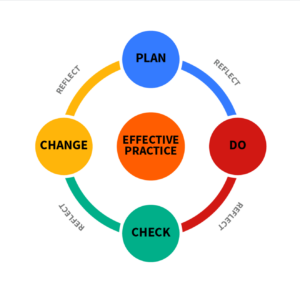Solid instruction begins with an analysis of student data followed by the development of targeted learning objectives/goals and instructional practices aimed at achieving them. District curriculum documents identify high-level learning objectives. Student Learning Objectives/Outcomes (SLOs) are growth targets set by teachers to help them plan instruction and drive learning throughout the year. SLOs are guided by the district curriculum and based on student data. SLOs also provide schools and districts with a way to make best instructional practice a common expectation for all teachers.
Here are four ways teachers can use their materials to achieve SLOs:

(1) After the focus of an SLO has been identified, check for causal connections between students’ learning deficits and deficits in the alignment of the district/campus’ instructional materials you have been using. Verify the alignment of any citations (lessons, activities, quizzes) you are planning to use to the standards students are struggling with.
- Learning List’s alignment report for each material identifies which citations listed in the publisher’s correlation are aligned to each standard and which citations are not aligned.
(2) Use your existing materials to scaffold instruction from prior grade levels to address learning gaps that have persisted over multiple grade levels.
- Learning List’s alignment comparison tool and alignment report for each grade level make it easy for teachers to identify citations in their existing materials that are aligned to the standards students are struggling with at any grade level. [Read more…]
(3) If you have already used the content in your existing materials that is aligned to the standards students are struggling with, reusing the same content to reteach those standards is usually not an effective strategy. You will need to look for new materials or resources aligned to those standards.
- The Learning List will help you identify other materials available for the course you are teaching. Additionally, Learning List’s Fill-in–the-Gap(TM) tool and search-by-standard search filter make it easy to identify new materials, including free open educational resources that are aligned to specific standards.
(4) Investigate whether your existing materials have the supports students need to learn the content and/or skills they are lacking. Consider also whether the materials you intend to use are engaging and sufficiently rigorous to help your students achieve their learning objectives and whether the materials will help you measure their progress.
- Learning List’s editorial reviews identify the material’s instructional model, supports for special populations, resources for differentiating instruction, and progress monitoring tools.